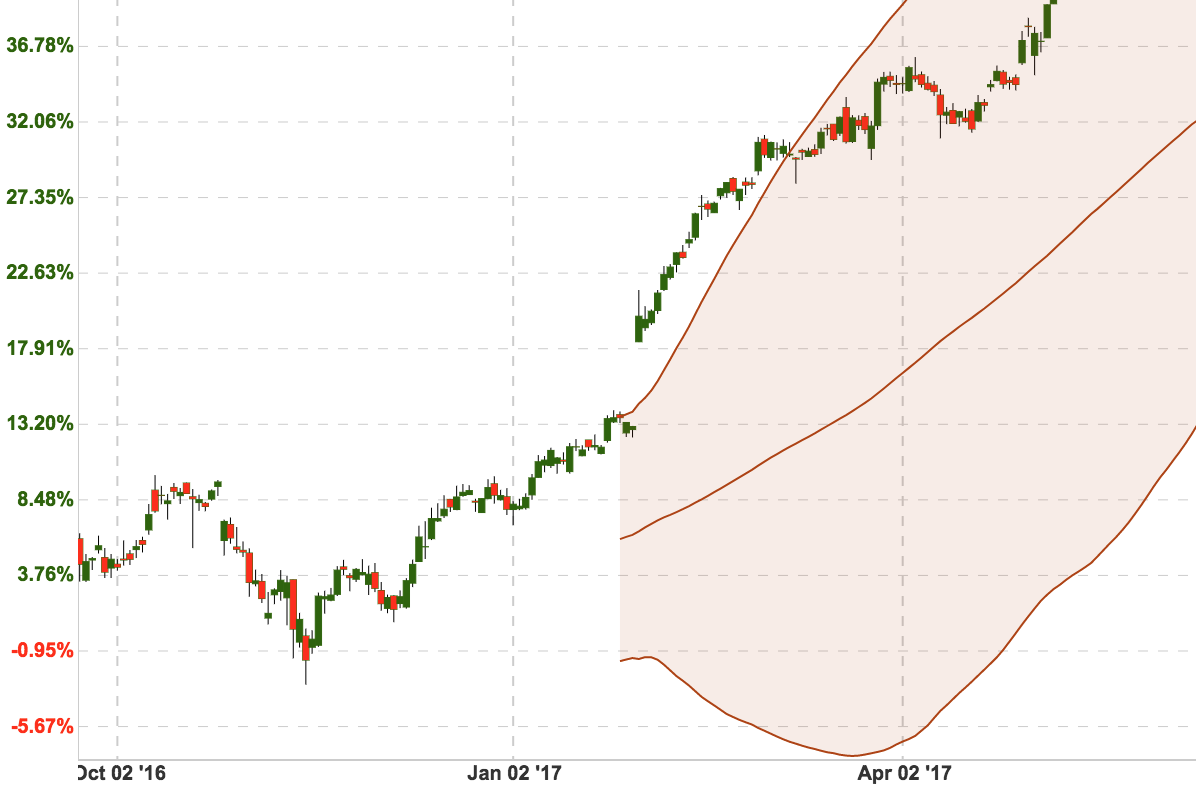-
-
Notifications
You must be signed in to change notification settings - Fork 6k
New issue
Have a question about this project? Sign up for a free GitHub account to open an issue and contact its maintainers and the community.
By clicking “Sign up for GitHub”, you agree to our terms of service and privacy statement. We’ll occasionally send you account related emails.
Already on GitHub? Sign in to your account
Filled Line Chart #2863
Comments
|
take a look at |
|
I managed to achieve this by following @liuxuan30 's suggestions by subclassing class AreaFillFormatter: IFillFormatter {
var fillLineDataSet: LineChartDataSet?
init(fillLineDataSet: LineChartDataSet) {
self.fillLineDataSet = fillLineDataSet
}
public func getFillLinePosition(dataSet: ILineChartDataSet, dataProvider: LineChartDataProvider) -> CGFloat {
return 0.0
}
public func getFillLineDataSet() -> LineChartDataSet {
return fillLineDataSet ?? LineChartDataSet()
}
}class CustomLineChartRenderer: LineChartRenderer {
override open func drawLinearFill(context: CGContext, dataSet: ILineChartDataSet, trans: Transformer, bounds: XBounds) {
guard let dataProvider = dataProvider else { return }
let areaFillFormatter = dataSet.fillFormatter as? AreaFillFormatter
let filled = generateFilledPath(
dataSet: dataSet,
fillMin: dataSet.fillFormatter?.getFillLinePosition(dataSet: dataSet, dataProvider: dataProvider) ?? 0.0,
fillLineDataSet: areaFillFormatter?.getFillLineDataSet(),
bounds: bounds,
matrix: trans.valueToPixelMatrix)
if dataSet.fill != nil
{
drawFilledPath(context: context, path: filled, fill: dataSet.fill!, fillAlpha: dataSet.fillAlpha)
}
else
{
drawFilledPath(context: context, path: filled, fillColor: dataSet.fillColor, fillAlpha: dataSet.fillAlpha)
}
}
fileprivate func generateFilledPath(dataSet: ILineChartDataSet, fillMin: CGFloat, fillLineDataSet: ILineChartDataSet?, bounds: XBounds, matrix: CGAffineTransform) -> CGPath
{
let phaseY = animator?.phaseY ?? 1.0
let isDrawSteppedEnabled = dataSet.mode == .stepped
let matrix = matrix
var e: ChartDataEntry!
var fillLineE: ChartDataEntry?
let filled = CGMutablePath()
e = dataSet.entryForIndex(bounds.min)
fillLineE = fillLineDataSet?.entryForIndex(bounds.min)
if e != nil
{
if let fillLineE = fillLineE
{
filled.move(to: CGPoint(x: CGFloat(e.x), y: CGFloat(fillLineE.y * phaseY)), transform: matrix)
}
else
{
filled.move(to: CGPoint(x: CGFloat(e.x), y: fillMin), transform: matrix)
}
filled.addLine(to: CGPoint(x: CGFloat(e.x), y: CGFloat(e.y * phaseY)), transform: matrix)
}
// Create the path for the data set entries
for x in stride(from: (bounds.min + 1), through: bounds.range + bounds.min, by: 1)
{
guard let e = dataSet.entryForIndex(x) else { continue }
if isDrawSteppedEnabled
{
guard let ePrev = dataSet.entryForIndex(x-1) else { continue }
filled.addLine(to: CGPoint(x: CGFloat(e.x), y: CGFloat(ePrev.y * phaseY)), transform: matrix)
}
filled.addLine(to: CGPoint(x: CGFloat(e.x), y: CGFloat(e.y * phaseY)), transform: matrix)
}
// Draw a path to the start of the fill line
e = dataSet.entryForIndex(bounds.range + bounds.min)
fillLineE = fillLineDataSet?.entryForIndex(bounds.range + bounds.min)
if e != nil
{
if let fillLineE = fillLineE
{
filled.addLine(to: CGPoint(x: CGFloat(e.x), y: CGFloat(fillLineE.y * phaseY)), transform: matrix)
}
else
{
filled.addLine(to: CGPoint(x: CGFloat(e.x), y: fillMin), transform: matrix)
}
}
// Draw the path for the fill line (backwards)
if let fillLineDataSet = fillLineDataSet {
for x in stride(from: (bounds.min + 1), through: bounds.range + bounds.min, by: 1).reversed()
{
guard let e = fillLineDataSet.entryForIndex(x) else { continue }
if isDrawSteppedEnabled
{
guard let ePrev = fillLineDataSet.entryForIndex(x-1) else { continue }
filled.addLine(to: CGPoint(x: CGFloat(e.x), y: CGFloat(ePrev.y * phaseY)), transform: matrix)
}
filled.addLine(to: CGPoint(x: CGFloat(e.x), y: CGFloat(e.y * phaseY)), transform: matrix)
}
}
filled.closeSubpath()
return filled
}
} |
|
perfect example to mastering the project :) |
|
how to resolve/ use this solution? |
|
@rob-k can you please provide usage example for this |
|
Sure, I use the code as follows: let maxDataSet = LineChartDataSet()
let minDataSet = LineChartDataSet()
// ... fill the data sets
// Set the data
self.lineChart.data = LineChartData(dataSets: [maxDataSet, minDataSet])
// Set the custom line chart renderer
self.lineChart.renderer = CustomLineChartRenderer(dataProvider: self.lineChart, animator: self.lineChart.chartAnimator, viewPortHandler: self.lineChart.viewPortHandler)
maxDataSet.drawFilledEnabled = true
maxDataSet.fillFormatter = AreaFillFormatter(fillLineDataSet: minDataSet) |
|
i installed this manually and followed each step as per example still looks like its not working @rob-k |
|
@rob-k i tried to debug using break points any of function from CustomLineChartRenderer not being called |
|
I updated my comment to include setting the |
|
still no luck man @rob-k |
|
If you want the color between ucbDataSet.fillFormatter = AreaFillFormatter(fillLineDataSet: lcbDataSet)(or the other way around) |
|
already tried what i am trying to explain is |
|
I see that you are using Bezier mode in your code: lineChartDataSet.mode = .horizontalBezier
ucbDataSet.mode = .horizontalBezier
lcbDataSet.mode = .horizontalBezierThe code I provided only works for linear mode. You will have to change the mode to |
|
@rob-k got it just worked thanks very much man for finding it out |
|
Would it be possible to implement this using CombinedChart ? |
did you find the solution ? the CombinedChart use the CombinedChartRender , not the LinearChartRender , so the call back is not called the method |
solution combinedChart : PhilJay/MPAndroidChart#338 |
|
@rob-k Thank you for sharing the example. It works perfectly for the first drawing. If I change the dateset, it looks like the old chart and the new chart are mixed or duplicated. How to clean the preview chart and draw the new chart using the new dataset? Thank you for your help in advance. |
|
@komunamu can your share the code that you use to update the chart data? If you simply replace the data set arrays and call |
|
@komunamu hello, could you share your code of the amazing charts? Thanks a lot! |
|
@AlexChzuang Sorry I don't have the source code. I think the updated demo code has the sample code that filled the line chart. Good luck! |
|
This has been a great help |

I'm trying to draw a filled line chart, you guys can see the picture for more clarity.

So, I saw the example and they are using IFillFormatter protocol to get y-axis position where the filled line of dataset end. But, it was a fixed position, not dynamic at all. How can I can this position depend on the each element of dataset. For instance, if index == 0 then we have a the end of filled position A, if index == 1 then we have a different end value of a filled position.
Or, any other suggestion to draw a chart like the picture above.
The text was updated successfully, but these errors were encountered: